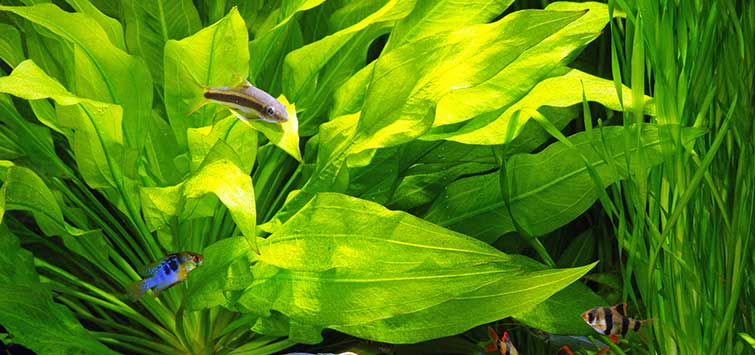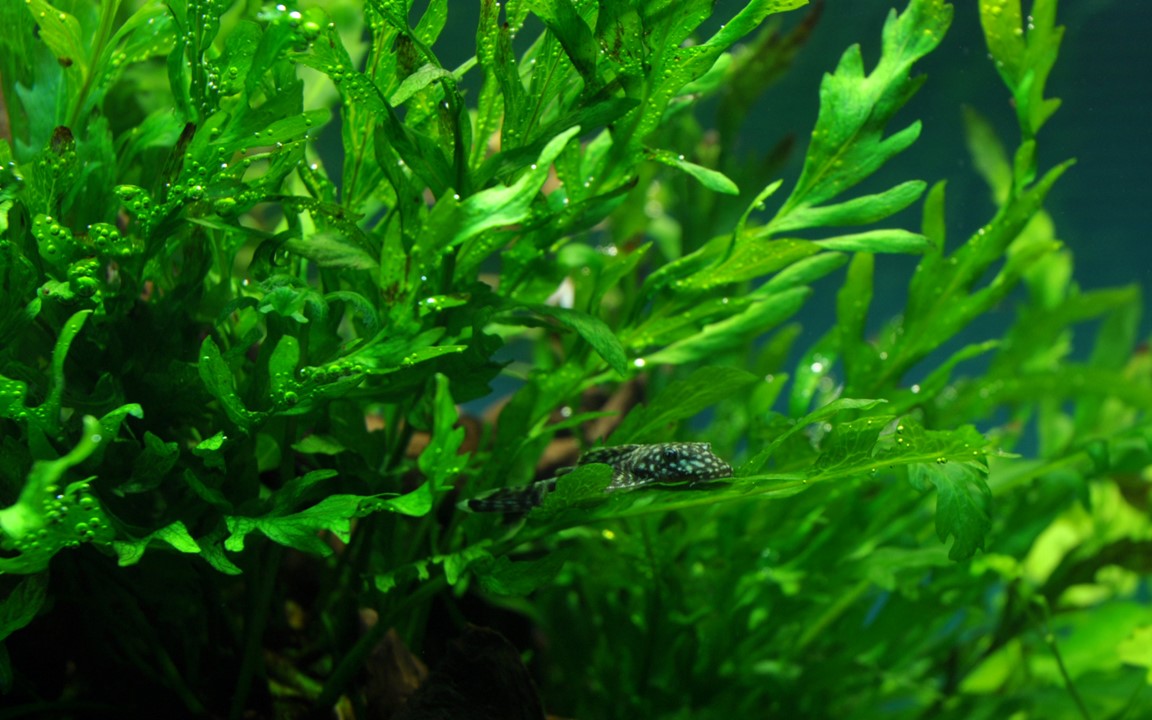Proper pruning of aquarium plants.
30 May 2024
0 Comments
Pruning aquarium plants is a basic care procedure. Plants pruned at the proper moment of growth will reward us with exemplary conditions. If left uncut or with little care, they will rot in the lower parts and, as a result, we will lose valuable species. Thanks to proper pruning, we can mold plants into various shapes. We can cut leaves that are damaged or show some defects.
Each amat eur The aquarist who likes to grow plants in his aquarium goes through several stages in his aquarium career. In the beginning, we try our best to make anything grow, but due to the lack of basic knowledge, our plants end up in the toilet and the process of rotting becomes an insurmountable obstacle. Not giving up, we went further and started searching the depths of the internet for answers to the question - what are we doing wrong? We finally had it! -- Of course we just thought so. We've learned something about potassium and other macronutrients as well as iron and other micronutrients. Plants grow and indescribable joy overwhelms us. They grow as fast as they can ...... At this stage, we still think of plants as being right next to, and sometimes above, the ground. However, this idyll doesn't last long and due to the lack of light in the lower parts, the plants start to rot, the old leaves fall off and everything goes into the filter and can't cope any more. Again, almost all of the flora falls onto the composter and our aquarium is back to square one. This can be avoided by pruning the plants at the right time. Deciding to prune at the right time is a matter of experience, which you will certainly gain over time.
Equipment
It is worth equipping yourself with a pair of scissors for aquarium use. In stores we can meet scissors: straight, wavy and curved. The first of them is the most widespread. They are suitable for almost any method of pruning, although in some cases they can be inconvenient (trimming lawn plants). Wave scissors are mainly recommended for trimming lawn plants. Their shape allows easy pruning of low plants, even in hard-to-reach places. However, curved ones are also versatile, and they are most often used for trimming stemmed plants or cutting runners.
Depending on the plant, pruning options vary. Below we will cover basic information and methods for pruning water plants.
Lawn Plants
Prune lawn plants (e.g. Hemianthus callitrichoides, Eleocharis parvula, Glossostigma elatinoides) when they are taller than about 2 cm. Mowing makes the plants grow densely (the lawn becomes denser). As soon as Eleocharis forgives us irregular, rare cuts, Hemianthus approaches the subject relentlessly. After a few weeks uncut and oversized, it will begin to come out of the ground. When the rotting process gets too deep, it needs to be replanted with fresh, healthy seedlings.
Dried plants
Trim stem plants (e.g. Rotala, Bacopa, Cabonba, Hygrophila) in the section between the nodes. The cut off upper part of the stem can be planted in the substrate - it will continue to grow. Trimming stem plants causes the plant to grow to the side (new shoots will grow at the crossing), so the plant is dense. When pruning stem plants it is our practice to give them the desired shape. Small-leaved stem plants like Rotala can be pruned like a hedge; after a few days, the pruned stems will grow new, prettier shoots. Plants like Hygrophila have larger leaves and we need to cut them more sensitively. Large leaves cut in half look less attractive and if left in this form it will rot and fall off.
Rosette plants (e.g. Cryptocoryne, Echinodorus)
Trim old leaves and/or leaves with any defects (holes, yellowing and other signs of defects). The cutting position should be as close to the ground as possible. After cutting old leaves, the plant will begin to release new leaves more quickly. Non-predefined diagonal scissors may be helpful here.
Rooted plants (e.g. Anubias, Microsorum, Bolbitis)
We can distinguish two techniques of trimming. The first - pruning old leaves on the rhizome. The second technique is used for growing new plant seedlings - cutting off a piece of rhizome (it must have at least a few leaves). Then we attach it to the substrate (stone, roots, lava, etc.). Vallisneria and other long, broad-leaved plants
Vallisneria and other long, broad-leaved plants
The trimming scheme is similar to the above. Bittercress plants in particular start to rot at the cut-off point - it doesn't look pretty, so you can cut the leaves as low as possible. Often, however, cutting the plant close to the substrate will disrupt the entire arrangement for weeks, so you can cut bitterbrush at the surface and systematically tear off the single leaf that begins to rot at the very bottom.
Moss.
We just cut away the moss! It pays to capture the truncated pieces immediately. You can do this by hand or with a small diameter hose (approx. 0.4 - 1 cm) - to suck up the water and collect the plant fragments. Moss, due to the very poor root system called rhizomes, will quickly detach from the ground if not pruned regularly.
Experience ...... is something you can't get from reading articles, but you have to start somewhere. So with scissors in hand, check if your plants need some pruning SPA!
Each amat eur The aquarist who likes to grow plants in his aquarium goes through several stages in his aquarium career. In the beginning, we try our best to make anything grow, but due to the lack of basic knowledge, our plants end up in the toilet and the process of rotting becomes an insurmountable obstacle. Not giving up, we went further and started searching the depths of the internet for answers to the question - what are we doing wrong? We finally had it! -- Of course we just thought so. We've learned something about potassium and other macronutrients as well as iron and other micronutrients. Plants grow and indescribable joy overwhelms us. They grow as fast as they can ...... At this stage, we still think of plants as being right next to, and sometimes above, the ground. However, this idyll doesn't last long and due to the lack of light in the lower parts, the plants start to rot, the old leaves fall off and everything goes into the filter and can't cope any more. Again, almost all of the flora falls onto the composter and our aquarium is back to square one. This can be avoided by pruning the plants at the right time. Deciding to prune at the right time is a matter of experience, which you will certainly gain over time.
Equipment
It is worth equipping yourself with a pair of scissors for aquarium use. In stores we can meet scissors: straight, wavy and curved. The first of them is the most widespread. They are suitable for almost any method of pruning, although in some cases they can be inconvenient (trimming lawn plants). Wave scissors are mainly recommended for trimming lawn plants. Their shape allows easy pruning of low plants, even in hard-to-reach places. However, curved ones are also versatile, and they are most often used for trimming stemmed plants or cutting runners.
Depending on the plant, pruning options vary. Below we will cover basic information and methods for pruning water plants.
Lawn Plants
Prune lawn plants (e.g. Hemianthus callitrichoides, Eleocharis parvula, Glossostigma elatinoides) when they are taller than about 2 cm. Mowing makes the plants grow densely (the lawn becomes denser). As soon as Eleocharis forgives us irregular, rare cuts, Hemianthus approaches the subject relentlessly. After a few weeks uncut and oversized, it will begin to come out of the ground. When the rotting process gets too deep, it needs to be replanted with fresh, healthy seedlings.

Dried plants
Trim stem plants (e.g. Rotala, Bacopa, Cabonba, Hygrophila) in the section between the nodes. The cut off upper part of the stem can be planted in the substrate - it will continue to grow. Trimming stem plants causes the plant to grow to the side (new shoots will grow at the crossing), so the plant is dense. When pruning stem plants it is our practice to give them the desired shape. Small-leaved stem plants like Rotala can be pruned like a hedge; after a few days, the pruned stems will grow new, prettier shoots. Plants like Hygrophila have larger leaves and we need to cut them more sensitively. Large leaves cut in half look less attractive and if left in this form it will rot and fall off.
Rosette plants (e.g. Cryptocoryne, Echinodorus)
Trim old leaves and/or leaves with any defects (holes, yellowing and other signs of defects). The cutting position should be as close to the ground as possible. After cutting old leaves, the plant will begin to release new leaves more quickly. Non-predefined diagonal scissors may be helpful here.

Rooted plants (e.g. Anubias, Microsorum, Bolbitis)
We can distinguish two techniques of trimming. The first - pruning old leaves on the rhizome. The second technique is used for growing new plant seedlings - cutting off a piece of rhizome (it must have at least a few leaves). Then we attach it to the substrate (stone, roots, lava, etc.).
The trimming scheme is similar to the above. Bittercress plants in particular start to rot at the cut-off point - it doesn't look pretty, so you can cut the leaves as low as possible. Often, however, cutting the plant close to the substrate will disrupt the entire arrangement for weeks, so you can cut bitterbrush at the surface and systematically tear off the single leaf that begins to rot at the very bottom.
Moss.
We just cut away the moss! It pays to capture the truncated pieces immediately. You can do this by hand or with a small diameter hose (approx. 0.4 - 1 cm) - to suck up the water and collect the plant fragments. Moss, due to the very poor root system called rhizomes, will quickly detach from the ground if not pruned regularly.

Experience ...... is something you can't get from reading articles, but you have to start somewhere. So with scissors in hand, check if your plants need some pruning SPA!
Tags:












































































































